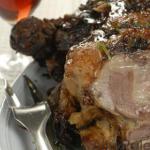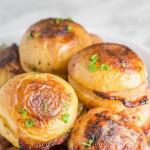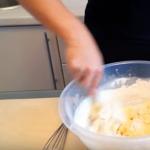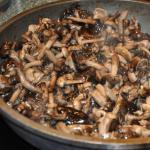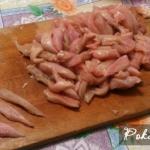Why the dough is dry and hard. How to make the crust of baking thin and delicate
→
So my grandmother taught me how to make pies - a pastry chef and a cook from God. I try to keep her skill, every time I remember my granny - the wisest and kindest woman of my life. So:
half a liter of milk at room temperature, 150-200 gr. margarine (but no more!) is also at room temperature, 25 grams of yeast, 1 tsp. salt and 2 tbsp. l sugar, flour about 1 kg. Notice, I do not put an egg in the dough. Put the dough. Dissolve the yeast in a small amount of milk, add a little sugar and flour and put the dishes with dough in a bowl with hot water. Attention! the dough should take about 1/2 of the dishes (usually I take a tall cup for this purpose). In a sufficiently large container, mix the flour, margarine, sugar, salt, milk. I decided to make primary mixing with a knife, the dough doesn’t stick to it as much as on a spoon or on my hand. We look at how the couple behaves. She must rise with a hat over the dishes. When the dough has risen, pour it into the kneaded dough, add flour, if necessary, and begin to knead by hand. Here you need to watch to add flour if necessary, because the dough is thinner when proofing. I knead for 10-15 minutes, pour a little vegetable oil into my palm, so that it is better kneaded and does not stick to the hands and walls of the dishes.
Very important! don't get carried away with the amount of margarine! He keeps the dough from rising and makes it heavy. Very good effect on the dough kneading. grandmother said - "Good mocking is better than butter." When the dough begins to lag behind the hands and the walls of the dishes, put in a warm place for proofing. I usually plug a sink, pour hot water there and put a pot of dough (You can put it in a basin of hot water). The dough should come up TWO times. The first time fits quite a while (depending on the yeast). Sediment with a greased hand oil and let rise a second time. After rising a second time, precipitate, knead and fall out onto a table sprinkled with flour (a little!). Do not get carried away with flour, so that the dough is not dry. Further. cover the dough with a clean towel and from the edge in a circle we begin to cut pieces about the size of a chicken egg. It is better to cut all the dough at once. Then carefully cut the koloboks, with fingers, into a flat cake. My grandmother did it not in weight so as not to squeeze the dough once again. We start with any filling. Then another subtlety. In the photo, Irina has pies with the seam up. But I basically make them with the seam down, and remove the sharp corners "under the tummy" of the pie, so they are all the same shape, oval.
I grease the baking sheet with vegetable oil (again with my hand) and spread the stuffed pies with a sufficient distance from each other. 12 pies fit on my baking sheet. I believe that the pasties that stick together during baking are a marriage at work. From above, I grease them with a loose egg and sprinkle them as I said. After the pies are browned, I take them out, MANDATORY spray with water on top and cover with a clean linen towel to rest. Then they turn out exactly the same as in the photo, not hard and not dry, despite the fact that they are rosy. Text is hidden
Pies burn, dry, do not bake? Can't get a golden and crispy crust? It is not necessary to think about buying a new oven, it is quite possible to agree with the one that already exists, especially if you know a few secrets.
Possible causes of dry baking
Delicious golden pastries are a real art, not subject to all housewives, often it comes with age and experience. Each cook has his own company secrets and tricks that he uses to prepare certain dishes. Cooking baked goods is particularly difficult, and the dough sometimes shows a truly capricious character. The modern white oven replaced the Russian stove, but the housewives still indulge their homemade cakes.
Sometimes baking in the oven can dry out, letting go of the whole painstaking cooking process. This happens for several annoying reasons.
- First of all, perhaps the oven is not sufficiently warmed up - in this case, the cakes are baked longer and dry. Before starting cooking, the oven must be well heated, and after you put the pastries in it, the temperature must be gradually reduced. When cooking, do not open the oven door - each time the temperature drops by about 10-20 degrees. Also, for greater effectiveness, you can grease the patties with butter. After the cake is already pulled out of the oven, you should sprinkle it with water and cover with a towel or tracing paper - this will soften the crust and make it tender.
- A violation of the temperature regime can also occur if the oven door does not close tightly - the fasteners are loose or something is stuck on the door. In this case, a temporary measure is to close the windows and windows in the kitchen, and lay the slots in the door with a damp towel.
- The electric oven has very dry air, so the pastries should be moistened. To do this, it is advised to put down a container of water - a frying pan or an aluminum pan. Such a simple measure will provide the necessary moisture to the dough. By the time the cake is to be put in, the water will already be heated, and, evaporating during baking, it will not let the cakes dry. Never place a baking dish on the bottom of the oven.
- Remember that each type of product needs its own temperature to bake. For example, pies from yeast dough should be baked at a temperature of at least 220 degrees. Baking can dry not only because of a violation of the temperature regime, but also because of the small presence of muffin.
- In whatever oven you cook - gas or electric - remember that you need to read the instructions for any oven, because when cooking it has its own nuances and difficulties.
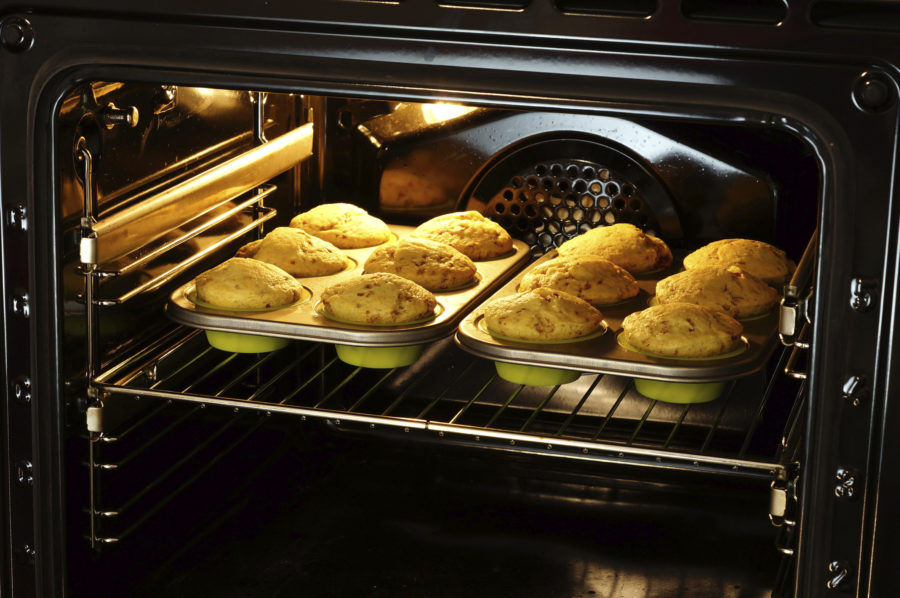 baking muffins in oven
baking muffins in oven Is there a problem in the oven?
Just note that an electric stove is much more convenient than a gas oven, since heating can go both above and below. Upper or lower heating elements may be included separately. In addition, the electric oven is equipped with a convenient thermostat and often a timer. It is like an iron, it turns off and on itself - it maintains a constant temperature.
Eclectic Oven Rules
- Before turning on, be sure to remove all excess objects from the oven. If there is a wire rack, but it will not be used, then it must be removed (the excess pan left in the oven will negatively affect the temperature and heating of the oven).
- Before baking, the oven must be heated: set the desired temperature and wait 15-20 minutes.
- If you need to put baking in a cold oven (for example, a glass or ceramic baking dish cannot be put in a red-hot oven - it will burst), then watch out for the dough. If it has already risen, and the oven has not yet warmed up, then you can put parchment moistened with water on top of the dough.
- A baking dish cannot be placed on the bottom of the oven, only on a wire rack or baking sheet. It is necessary to put on the guides in the oven.
- The electric oven has very dry air, so baking must be humidified. You can put a container of water in the oven for the first half of the baking time. You can also sprinkle seized pies with water or warm milk.
- Convection mode makes the air hot by 10-15 degrees.
- Any oven must not be opened during the preparation of the dough. When you put the pastries inside, close the door carefully, do not slam. Otherwise, the dough may fall.
- A toothpick will help you learn about the readiness of the test: you need to stick it in the dough, if there is no sticky dough left on it, then everything has been baked.
Rules for working with a gas oven
In it, heating is only from below and it is more difficult to regulate the temperature. Therefore, it often happens that pastries bake from below, and in the middle - do not bake. What to do?
- Before you put the pie, the oven needs to be heated for 10-15 minutes over the biggest fire. Then reduce the fire to medium or even to the minimum (if you feel that it is burning), and, checking the thermometer and adjusting the temperature, bake if necessary.
- Baking should be set so that there is enough space around it for air circulation.
- To protect the bottom of the dish from excessive heat, put a baking sheet with coarse salt or sand in the pan or baking pan with baking dish. Sometimes pans with water are placed under the product, but not in all cases this method is effective.
- An enamelled black pan is often attached to gas ovens - this is a container for collecting fat and is not baked in it. For baking, you need to use special forms and put them on a wire rack, or bake on a baking sheet.
- To get a golden crust, you need to bring the baking to readiness over low heat, and then add heat for 5 minutes. And then turn it off.
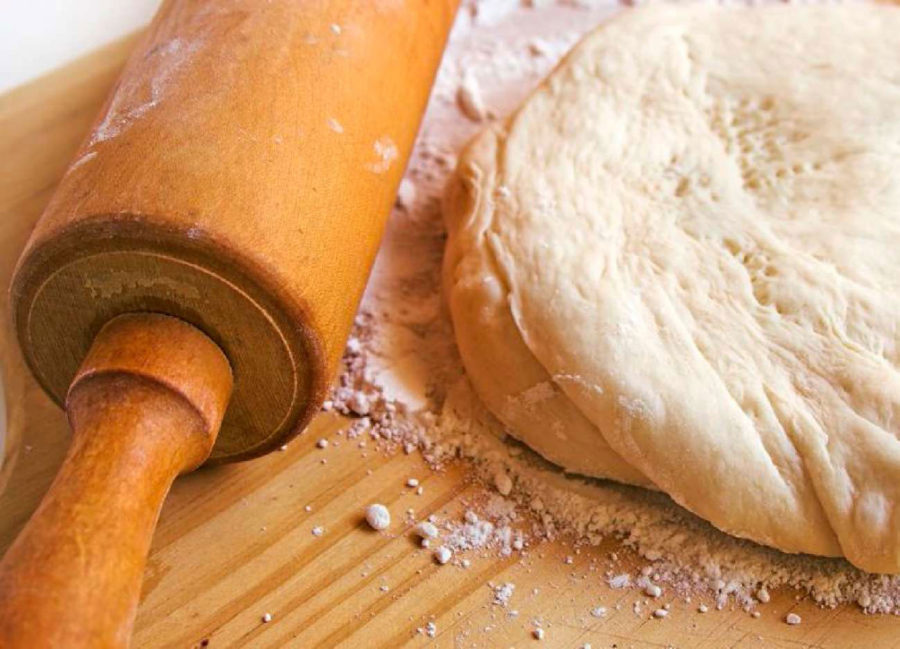
How to cook so that the pastries do not dry?
In whatever oven you are going to cook, it is best to read the instructions for it first. Even experienced cooks who have replaced several ovens can find a lot of interesting and useful things in the usual instructions.
Baking temperature:
- Yeast dough pies - 180 ° С
- High products - 175-190 ° С
- Small items, gingerbread cookies, pies - 210-220 ° С
- Pies from puff pastry - 200-220 ° C
- Meringues and meringues - 100-130 ° C
- To prevent the dough from sticking during baking in the oven, sprinkle a little salt under the mold, place an asbestos sheet under the baking sheet or substitute a pan filled with water.
- Cake should never be baked over high heat. In a hot oven, the outside of it will become solid, while inside it will remain damp. To prevent this from happening, you must first warm the oven, but do not heat it, and bake the cake at a moderate temperature.
- Shaking or moving a baking sheet or pan while baking pies or other items is not allowed.
- During the baking of pies or any dough products, the oven must not be opened for the first 10 minutes, since the dough will settle and not turn out lush.
- If a portion of the pie or cookie begins to burn, cover it with oiled paper.
- You should know that small products can withstand higher temperatures and bake faster than large ones.
- If there is no thermometer in the oven, then approximately the temperature can be determined by throwing a pinch of flour. If the flour turns yellow, and after 30 seconds it darkens, then this means that the temperature in the oven or oven is approximately 220-240 degrees. If the flour thrown into the furnace is instantly charred, then the temperature reaches about 270-280 degrees. When the flour turns yellow gradually, this indicates that the temperature in the oven is 180-200 degrees.
- Before baking puff pastry, be sure to refrigerate in the refrigerator, but do not freeze.
- Place the prepared products on a baking sheet moistened with cold water without lubricating it with oil.
- Baked dough is easier to take out of the mold if it is slightly cooled and then removed. Products from cottage cheese dough, which rise perfectly during baking, after removing them from the oven, quickly settle.
- After the cake is removed from the oven, it must be kept in the kitchen, and not taken out in the cold so that it does not donkey. To cut a crumbly cake, it is necessary to heat the knife by lowering it in boiling water. A stuffed cake will taste better if it lasts no less than half a day.
I came across an article about the secrets of successful baking. And the truth is interesting, why is it not always that the cake is airy, tender?
The author talks about the secrets of his grandmother. Maybe someone else will need these secrets.
So, the secrets of successful pies and pastries.
Sometimes the dough sticks to your hands, a little flour ... But if you add more, there will be no airiness, the dough will be cool. What is the way out? Usually the dough is rolled out with a rolling pin. If you pour cold water into a glass bottle, then this cool dough will roll out very easily.
If you grease your hands and the cutting table with vegetable oil, no dough will stick. Add a little vegetable oil to the pancake dough, and you will no longer need to grease the pan.
Thin dough is easier to roll out if the rolling pin is wrapped with a clean, ironed linen cloth. If the dough is very wet, it is easy to roll it through parchment paper to the desired height.
To get an airy and light crumbly fresh dough, you need to add a spoonful of cognac. It’s very good to add a little starch to the biscuit dough - the finished products will also be friable.
Sponge cake dough has its secrets. The egg-sugar mixture must not be mixed with flour for longer than 15 seconds! Otherwise, the dough will settle, and the biscuit will be dense, not airy.
And in a shortcrust pastry, flour should be mixed with other ingredients for no more than 2-3 minutes. Otherwise, it turns out too dense and stiff dough.
Yeast dough for fried pies should be of a weaker consistency than for baked pastries. Only then they turn out soft and airy.
To make the baking airy, the form needs to be filled only to half. This applies to biscuit and yeast dough.
When you lay out your yeast-cake pie on a baking sheet or in a mold, leave voids around it, the cake will be better baked.
Choux pastry and dough, in which there are a lot of proteins, cannot be shaken and moved in a mold or on a baking sheet, the products will immediately settle.
Puff pastry also has its secrets. Before baking, it should be cold, the butter in such a dough does not have time to melt, and the dough has time to rise. And you need to lay out products from puff pastry on a sheet moistened with cold water. Then such products will be easily removed after baking. Puff pastry is baked at a temperature of 210-230 degrees. At higher, it hardens; at lower, it does not blush, it becomes dry.
So that the dough does not burn in the oven, a little salt is poured under the form. If the products start to burn, cover the top with wet paper.
Yeast dough does not like to sit in the oven for a long time, it turns out dry. If you have pies or rolls, bake them for no more than 20 minutes at a temperature of 180-200 degrees. If the pie with the finished filling - no more than 30 minutes.
Any baking, except the one from which you will make roll, you need to give time to cool, only then they take it out. To make it well removed from the mold, remove it from the oven on a wet towel. Roll dough needs to be cooled only slightly. If it cools down completely, you will no longer roll the roll, everything will break.
Decorate with cream, icing, fruit, etc. ready-made cakes and pastries can only be fully cooled.
How to check if the products are baked? Gently press the finished biscuit or yeast dough with your finger. If the product fully and quickly recovers, and the volume does not decrease, you can congratulate yourself - your cake was a success!

